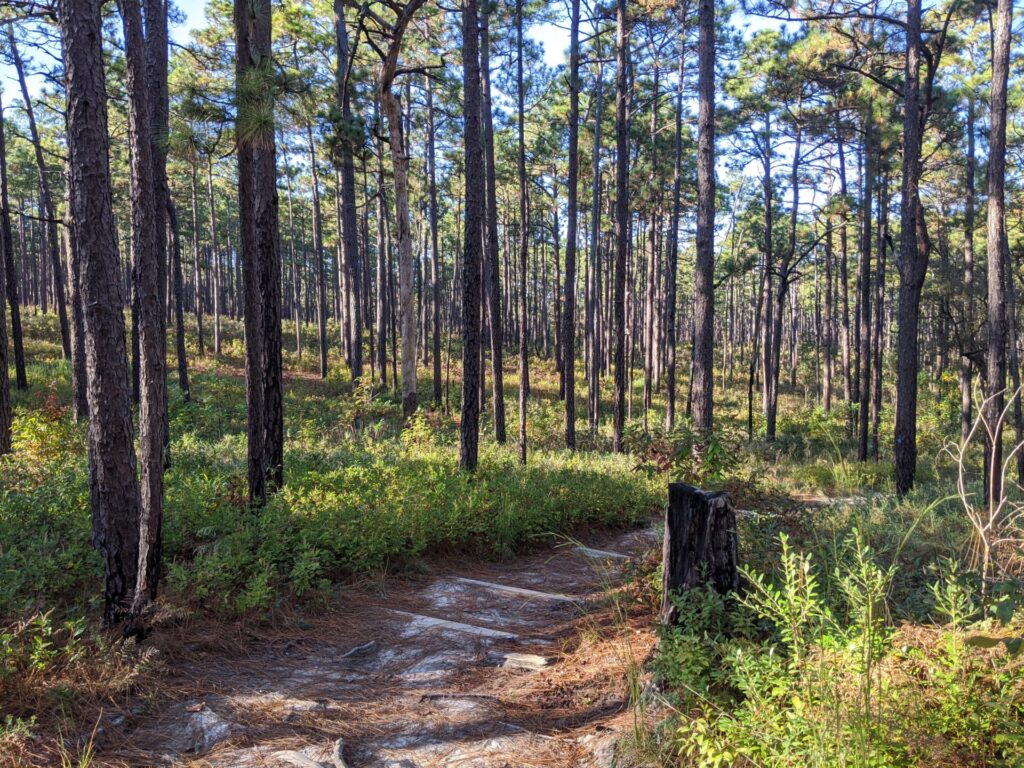By Julie Moore and Amy Mackintosh
Invitation-only areas in North Carolina’s western sandhills will showcase plant diversity and management practices. The October 15 Western Sandhills Field Trip sponsored by the NC Native Plant Society will focus on three areas of the Longleaf Pine (Pinus palustris) ecosystems.
There is a wait list
Register here for the wait list to the field trip and learn about specific tour information. Field trip registration is limited to 45 people, with 15 people per tour. Cost for the day is $20 for members ($45 for non-members, including a 1-year individual membership).
Tours will encompass the variety of plants that grow in sandhill Longleaf Pine forests and will demonstrate the management practices needed to sustain these fire-dependent ecosystems.
Plants will be at their blooming best
Fall is the best time to see the highest number of blooming plants in the Sandhills. One resource that participants may want to use is A Field Guide to Wildflowers of the Sandhills Region: North Carolina, South Carolina, and Georgia by Bruce A. Sorrie. Particularly noteworthy are the striking Pine-barren Gentian (Gentiana autumnalis), and several distinctive milkweeds including Sandhill Milkweed (Asclepias humistrata), blazing stars and gayfeathers, goldenrods, numerous asters and Threadleaf Gerardia (Agalinis setacea).
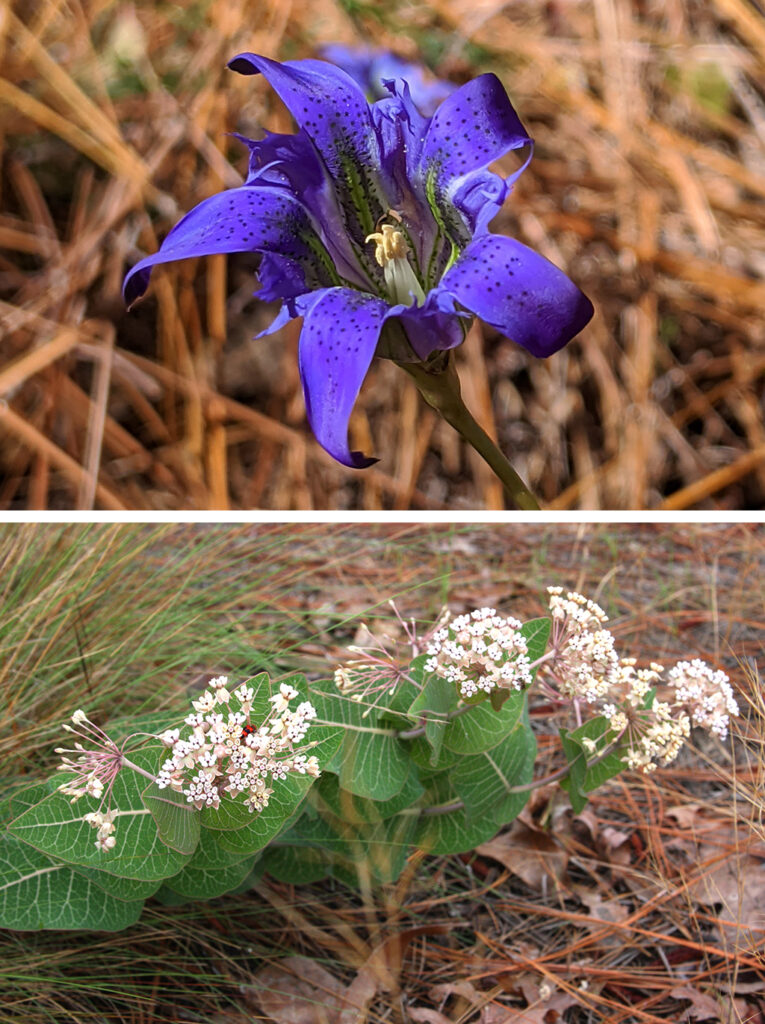
The field trip includes a morning session and an afternoon session. Each session will have three concurrent tours. Participants may choose one of the three tours in the morning and one of the three in the afternoon. Between tours we will gather at the Cannon Park picnic shelter in Pinehurst for lunch (bring your own) and a short talk by Julie Moore, a botanist, ecologist and Longleaf lover. The three tour sites are properties in the western sandhills that are only open by invitation. One is owned by the state’s Plant Conservation Program, one by a private landowner, and the most recently established one by a conservation nonprofit organization. The three are within close proximity in western Moore County.
The sites illustrate different aspects of conservation and management of Longleaf Pine ecosystems in the sandhills. All will include a diversity of fall-blooming wild flowers, plants and wildlife characteristic of these ecosystems.
Three tour properties
Eastwood Preserve
The Eastwood Preserve, located north of Pinehurst and east of West End, is part of the NC Plant Conservation Program, Department of Agriculture & Consumer Services and managed by the Plant Conservation Program. Three Rivers Land Trust recently added 15 acres to the preserve, bringing the total size to almost 400 acres. An additional tract will be added in the near future. Due to the sensitive nature of the species found on site, the site is only open to the public through workdays and guided tours.
This site is a significant natural heritage area as identified by the NC Natural Heritage Program, known primarily for its occurrence of the state-endangered Sandhills Lily (Lilium pyrophilum), which blooms for two weeks in early August. The lily is a relatively newly described species by botanist Bruce Sorrie, author of one of Southern Gateways Guides published by the University of North Carolina Press.This showy species is endemic to the 16 counties in the sandhills of southern Virginia, North Carolina and northern South Carolina. An estimated 250 populations are currently documented.
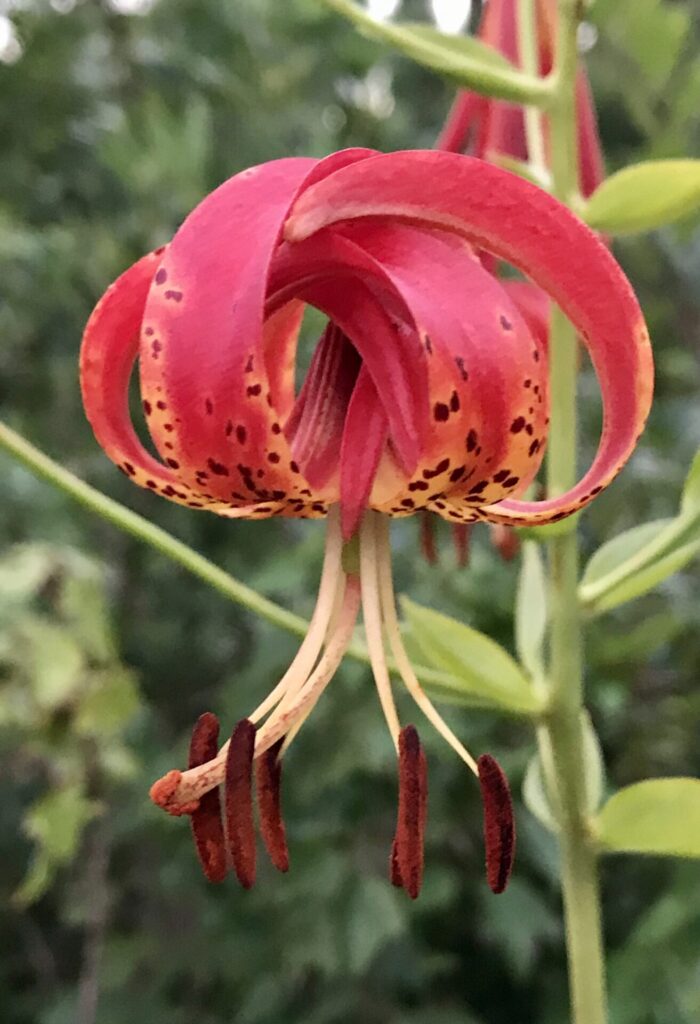
In the preserve the lilies occur mainly in an actively managed powerline right-of-way. The lily grows in wet, boggy places and is among a large suite of species that require open-canopy wetlands maintained mainly by fire or other disturbance such as mowing. Yellow Fringed Orchid (Platanthera ciliaris), Purple Pitcherplant (Sarracenia purpurea), and Pink Sundew (Drosera capillaris) are other fascinating plants in the wetland habitat surrounded by fire maintained sandhill Longleaf forests. The Carolina Lily (Lilium michauxii) was recently found in the drier portion of the preserve.
Our tour leaders are Jeff Marcus, resident preserve manager, and Lesley Starke, statewide manager of NC Plant Conservation Program. The tour will focus on the endemic flora of the sandhills and issues related to their conservation. While the lilies will no longer be blooming at the time of our visit, there will be plenty of fall bloomers to discover.
LighterWood Farm
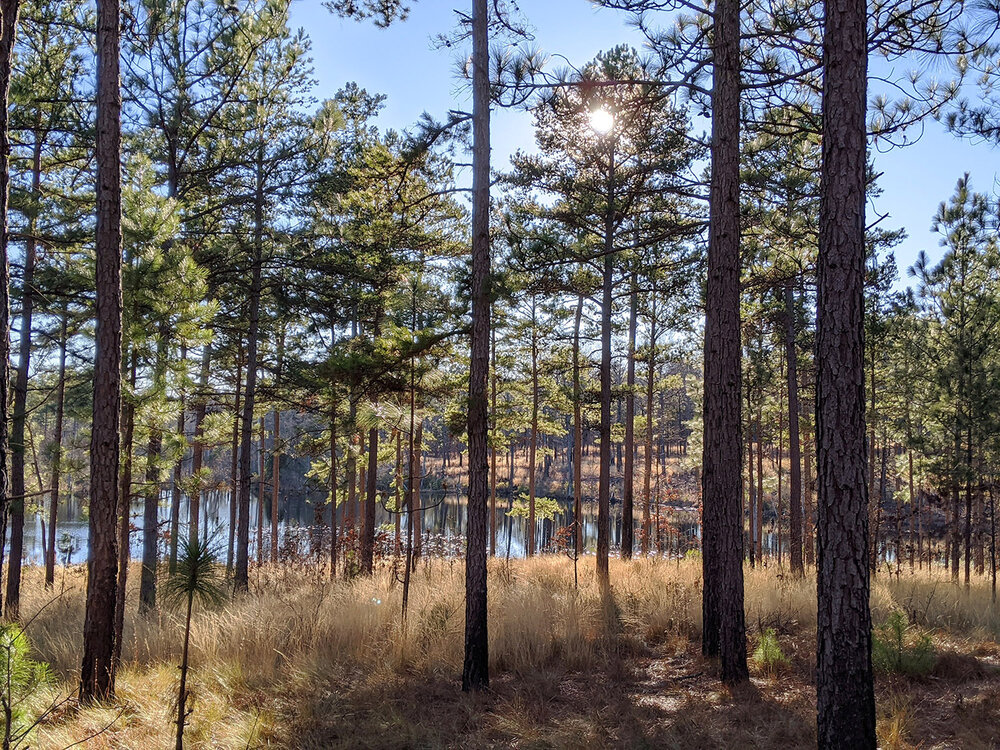
LighterWood Farm, a property that has been in the same family for generations, well demonstrates what sandhill land owners can do to enhance their Longleaf forests and generate income in several ways while conserving natural habitat and ecosystems. The property, which is enrolled in the U.S. Fish and Wildlife Services Safe Harbor Program for the Red-cockaded Woodpecker, is located west of Pinehurst, south of Carthage, and just east of West End.
The property includes Longleaf Pine forest areas protected by conservation easement, and Longleaf tracts managed for income, as well as a pond and wetlands. The Margaret Reid Chapter of the NC Native Plant Society visited LighterWood Farm in January 2022 and a YouTube video is available for you to preview.
Some of the most unique plant communities on LighterWood Farm are found in its seeps and stream head pocosins. These fire-dependent communities hold the highest percentage of unique and endemic plants in the sandhills. LighterWood Farm’s burn program has been geared toward opening up these sandhill seeps and pocosins. This effort has yielded insectivorous plants and orchids and other unique wetland species. Part of our tour will explore these fascinating plant communities.
The tour will focus on innovative and sustainable ways a private landowner can conserve habitat and natural resources while generating income. There will also be opportunities to botanize and discover the variety of fall-blooming plants that grow among Longleafs.
Jesse Wimberley, our tour leader and owner of LighterWood Farm, has deep roots in the sandhills. His family was recognized in September 2021 by the NC Longleaf Honor Roll for their long-term interest and outstanding management of their Longleaf Pine stands of several age classes. Jesse is the coordinator of the NC Sandhills Prescribed Burn Association, which works with private landowners in the NC sandhills to teach them about the benefits of prescribed burning and the techniques to do their own burning.
Nick’s Creek Longleaf Reserve
There is a unique, new preserve in the western NC sandhills located northwest of Pinehurst just to the west and upstream from the state’s Eastwood Preserve.
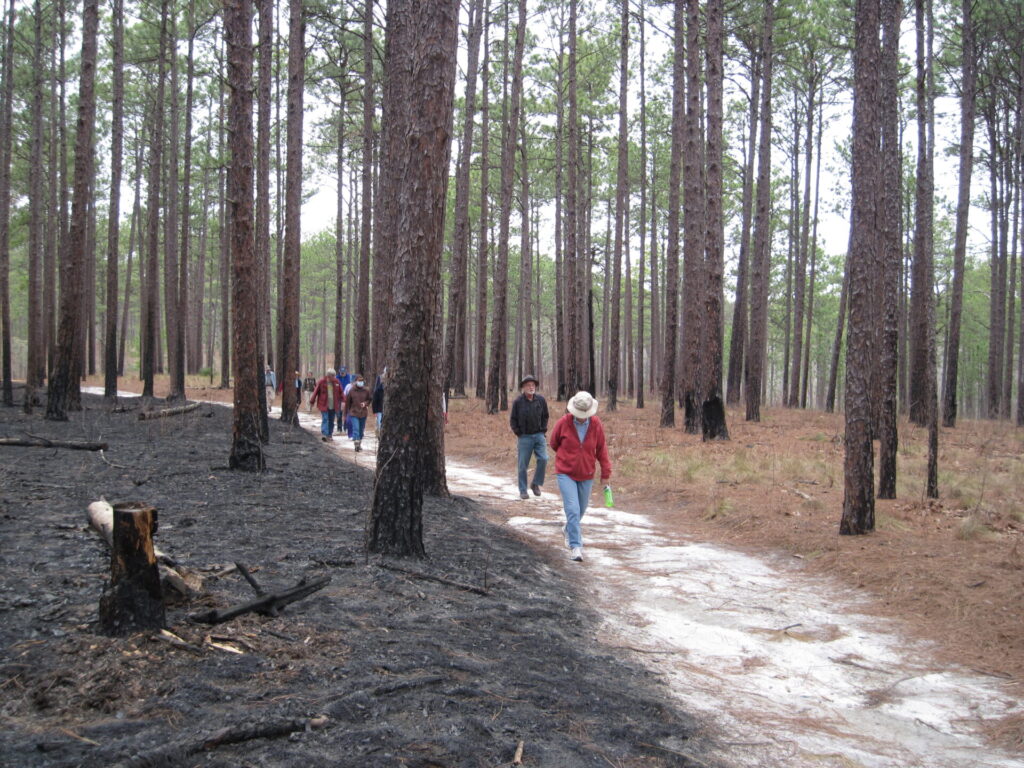
The 1,800-acre Nick’s Creek Longleaf Reserve was acquired in late 2019 by Southern Conservation Trust, a Georgia-based nonprofit that protects working farms, forests and historic landscapes through conservation easements and fee simple property donations.
A demonstration forest, not developed land
Nick’s Creek Longleaf Reserve, once destined to become a resort-like community of homes, hotel and spa, and two 18-hole golf courses, will instead be a demonstration forest.
The large acreage of rolling uplands, mainly Longleaf forest, including the headwaters of Nick’s Creek that runs from West End to Whispering Pines, will illustrate techniques to manage and restore Longleaf Pine forests. Based on the diversity of existing conditions, it is divided into units where different techniques of forest management and restoration will be utilized to show landowners, with or interested in Longleaf Pine management, different approaches, costs, and the potential income.
Melvin Ezzell and Julie Moore will be our tour leaders for this site. Melvin Ezzell, a registered forester who manages the reserve, said “Forestry doesn’t happen overnight; it is a process. It is a marathon, not a sprint. The ultimate goal at Nick’s Creek is to restore 1,200 acres to Longleaf savannah and serve as an outdoor classroom for landowners to see how they can see returns in forestry.”
Lunch speaker is Julie H. Moore
Julie Moore, botanist and ecologist, is an active member of the Margaret Reid (Triangle region) chapter of the NCNPS. Julie has a long history of professional and personal involvement in native plant conservation organizations and land trusts in North Carolina and nationally, with a particular interest in Longleaf Pine ecosystems.
Julie retired in 2019 from the U.S. Fish and Wildlife Service with the Endangered Species Program, Washington, D. C. She was national coordinator for Safe Harbor and Candidate Conservation Agreements.
Julie was with the North Carolina Natural Heritage Program for over a dozen years as a botanist and ecologist specializing in fire dependent systems and working with private landowners. She is the author of “Managing the Forest and the Trees,” a guide for Longleaf forest landowners funded by The Nature Conservancy and the Longleaf Alliance.
Julie is active in native plant conservation organizations and local land trusts, is past president of the Triangle Land Conservancy and Botanical Society of Washington, D.C., founding board member of the Longleaf Alliance, the B W Wells Association, and more recently, the Southern Conservation Partners, and serves as chairman of the NC Plant Conservation Program board.
Her current project is the Venusflytrapchampions.org to encourage management and conservation of the species.
By Julie Moore and Amy Mackintosh
Native Plant News – Fall 2022

Julie Moore is an active member of the Margaret Reid chapter (Triangle region) of the NCNPS. A botanist and ecologist, Julie has a long history of professional and personal involvement in native plant conservation organizations and land trusts in North Carolina and nationally, with a particular interest in Longleaf Pine ecosystems.

Amy Mackintosh is a co-chair of the Margaret Reid chapter (Triangle region) of the NCNPS, a retired landscape architect, and owner/steward of the Margaret Reid Wild Flower Garden in Raleigh.
Copyright © 2022 North Carolina Native Plant Society. All rights reserved.
